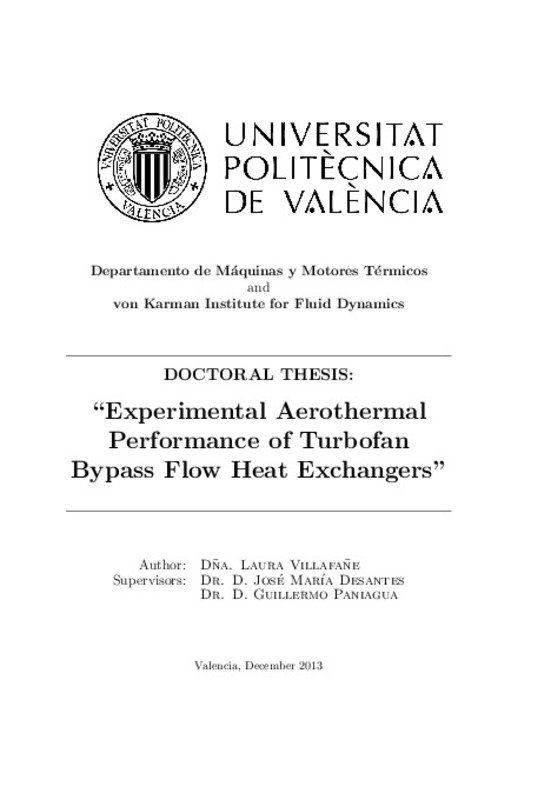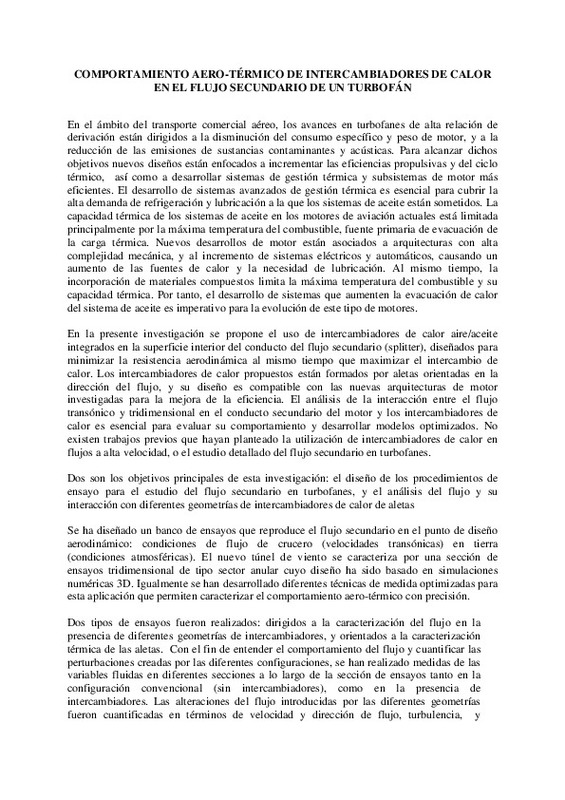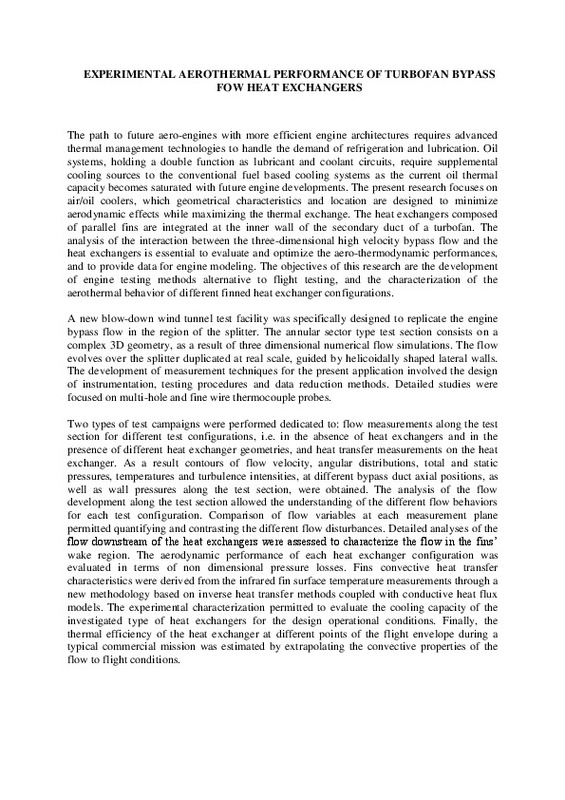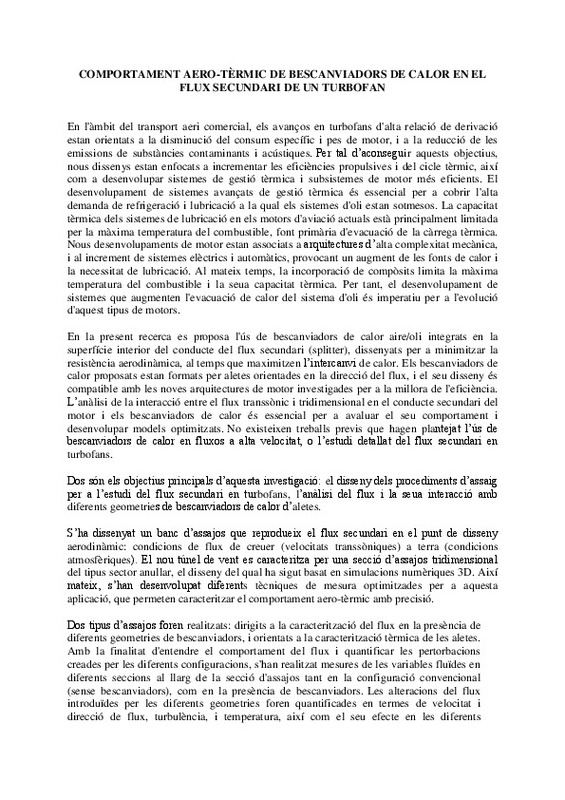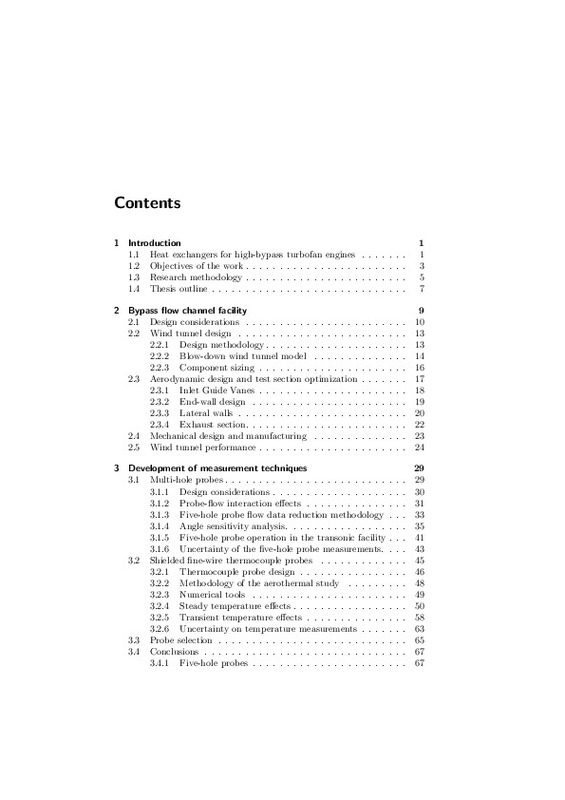- RiuNet repositorio UPV
- :
- Investigación
- :
- Tesis doctorales
- :
- Ver ítem
JavaScript is disabled for your browser. Some features of this site may not work without it.
Buscar en RiuNet
Listar
Mi cuenta
Estadísticas
Ayuda RiuNet
Admin. UPV
Experimental Aerothermal Performance of Turbofan Bypass Flow Heat Exchangers
Mostrar el registro sencillo del ítem
Ficheros en el ítem
| dc.contributor.advisor | Desantes Fernández, José Mª
|
es_ES |
| dc.contributor.advisor | Paniagua Pérez, Guillermo
|
es_ES |
| dc.contributor.author | Villafañe Roca, Laura
|
es_ES |
| dc.date.accessioned | 2014-01-07T07:46:29Z | |
| dc.date.available | 2014-01-07T07:46:29Z | |
| dc.date.created | 2013-12-12T10:00:07Z | es_ES |
| dc.date.issued | 2014-01-07T07:46:23Z | es_ES |
| dc.identifier.uri | http://hdl.handle.net/10251/34774 | |
| dc.description.abstract | The path to future aero-engines with more efficient engine architectures requires advanced thermal management technologies to handle the demand of refrigeration and lubrication. Oil systems, holding a double function as lubricant and coolant circuits, require supplemental cooling sources to the conventional fuel based cooling systems as the current oil thermal capacity becomes saturated with future engine developments. The present research focuses on air/oil coolers, which geometrical characteristics and location are designed to minimize aerodynamic effects while maximizing the thermal exchange. The heat exchangers composed of parallel fins are integrated at the inner wall of the secondary duct of a turbofan. The analysis of the interaction between the three-dimensional high velocity bypass flow and the heat exchangers is essential to evaluate and optimize the aero-thermodynamic performances, and to provide data for engine modeling. The objectives of this research are the development of engine testing methods alternative to flight testing, and the characterization of the aerothermal behavior of different finned heat exchanger configurations. A new blow-down wind tunnel test facility was specifically designed to replicate the engine bypass flow in the region of the splitter. The annular sector type test section consists on a complex 3D geometry, as a result of three dimensional numerical flow simulations. The flow evolves over the splitter duplicated at real scale, guided by helicoidally shaped lateral walls. The development of measurement techniques for the present application involved the design of instrumentation, testing procedures and data reduction methods. Detailed studies were focused on multi-hole and fine wire thermocouple probes. Two types of test campaigns were performed dedicated to: flow measurements along the test section for different test configurations, i.e. in the absence of heat exchangers and in the presence of different heat exchanger geometries, and heat transfer measurements on the heat exchanger. As a result contours of flow velocity, angular distributions, total and static pressures, temperatures and turbulence intensities, at different bypass duct axial positions, as well as wall pressures along the test section, were obtained. The analysis of the flow development along the test section allowed the understanding of the different flow behaviors for each test configuration. Comparison of flow variables at each measurement plane permitted quantifying and contrasting the different flow disturbances. Detailed analyses of the flow downstream of the heat exchangers were assessed to characterize the flow in the fins¿ wake region. The aerodynamic performance of each heat exchanger configuration was evaluated in terms of non dimensional pressure losses. Fins convective heat transfer characteristics were derived from the infrared fin surface temperature measurements through a new methodology based on inverse heat transfer methods coupled with conductive heat flux models. The experimental characterization permitted to evaluate the cooling capacity of the investigated type of heat exchangers for the design operational conditions. Finally, the thermal efficiency of the heat exchanger at different points of the flight envelope during a typical commercial mission was estimated by extrapolating the convective properties of the flow to flight conditions. | en_EN |
| dc.language | Inglés | es_ES |
| dc.publisher | Universitat Politècnica de València | es_ES |
| dc.rights | Reserva de todos los derechos | es_ES |
| dc.source | Riunet | es_ES |
| dc.subject | Turbofan bypass flow | es_ES |
| dc.subject | Fin heat exchangers | es_ES |
| dc.subject | Bypass flow heat exchangers | es_ES |
| dc.subject | Air surface cooler | es_ES |
| dc.subject | Fin arrays | es_ES |
| dc.subject | Wind tunnel design | es_ES |
| dc.subject | Wind tunnel modelling | es_ES |
| dc.subject | Annular sector test section | es_ES |
| dc.subject | Instrumentation design | es_ES |
| dc.subject | Five-hole probes | es_ES |
| dc.subject | Thermocouples | es_ES |
| dc.subject | Conjugate heat transfer | es_ES |
| dc.subject | Thermocouple errors | es_ES |
| dc.subject | Transonic cooling | es_ES |
| dc.subject | Convective heat transfer | es_ES |
| dc.subject | Inverse heat conduction | es_ES |
| dc.subject | Transonic flow measurements | es_ES |
| dc.subject | Aerothermal flow analyses | es_ES |
| dc.subject | Wake measurements | es_ES |
| dc.subject | Flow downstream fin arrays | es_ES |
| dc.subject | Flow direction measurements | es_ES |
| dc.subject | Turbulence intensity measurements | es_ES |
| dc.subject | Flow temperature deficit | es_ES |
| dc.subject | Pressure losses | es_ES |
| dc.subject | Fin adiabatic heat transfer | es_ES |
| dc.subject | Heat exchanger thermal characteristics | es_ES |
| dc.subject | Bypass flow pressure losses | es_ES |
| dc.subject | Thermal efficiency high speed heat exchangers | es_ES |
| dc.subject.classification | INGENIERIA AEROESPACIAL | es_ES |
| dc.subject.classification | MAQUINAS Y MOTORES TERMICOS | es_ES |
| dc.title | Experimental Aerothermal Performance of Turbofan Bypass Flow Heat Exchangers | |
| dc.type | Tesis doctoral | es_ES |
| dc.identifier.doi | 10.4995/Thesis/10251/34774 | es_ES |
| dc.rights.accessRights | Abierto | es_ES |
| dc.contributor.affiliation | Universitat Politècnica de València. Departamento de Máquinas y Motores Térmicos - Departament de Màquines i Motors Tèrmics | es_ES |
| dc.description.bibliographicCitation | Villafañe Roca, L. (2013). Experimental Aerothermal Performance of Turbofan Bypass Flow Heat Exchangers [Tesis doctoral]. Universitat Politècnica de València. https://doi.org/10.4995/Thesis/10251/34774 | es_ES |
| dc.description.accrualMethod | TESIS | es_ES |
| dc.type.version | info:eu-repo/semantics/acceptedVersion | es_ES |
| dc.relation.tesis | 6918 | es_ES |
Este ítem aparece en la(s) siguiente(s) colección(ones)
-
Tesis doctorales [5389]






